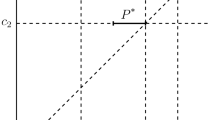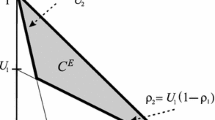Abstract
For duopoly models, we analyse the concept of coarse correlated equilibrium using simple symmetric devices that the players choose to commit to in equilibrium. In a linear duopoly game, we prove that Nash-centric devices, involving a sunspot structure, are simple symmetric coarse correlated equilibria. Any small unilateral perturbation from such a structure fails to be an equilibrium.
Similar content being viewed by others
Notes
Although this notion is due to Moulin and Vial (1978), they have not named the equilibrium concept. They have called such a correlation device a correlation scheme. Young (2004) and Roughgarden (2009) called this equilibrium the coarse correlated equilibrium, while Forgó (2010) called it the weak correlated equilibrium.
We thank an anonymous referee and Ferenc Forgó for the interpretation of our result.
One can also think of behavioral strategies in any extended game. We however, in this paper, restrict ourselves to pure strategies only.
It is also easy to prove that the set of correlated and coarse correlated equilibria coincide for the case of \(2\times 2\) games. However, as Moulin and Vial (1978) demonstrated, there are games involving two players and three strategies for each player, for which the set of coarse correlated equilibria is strictly larger than the sets of correlated and Nash equilibria.
Formally, let \(NE(G),\;CONV(G),\;CE(G)\) and \(CCE(G)\) denote, respectively, the sets of all Nash equilibria, convex combination of Nash equilibria, correlated equilibria and coarse correlated equilibria for any game \(G.\) Clearly, \(NE(G)\subseteq CONV(G)\subseteq CE(G)\subseteq CCE(G).\)
We thank an anonymous referee for suggesting Lemmata 1 and 2 to prove Theorems 1 and 2 directly using them.
We thank Ferenc Forgó and an anonymous referee for suggesting some of these issues.
References
Aumann RJ (1974) Subjectivity and correlation in randomized strategies. J Math Econ 1:67–96
Aumann RJ (1987) Correlated equilibrium as an expression of Bayesian rationality. Econometrica 55:1–18
Aumann RJ, Peck J, Shell K (1988) Asymmetric information and sunspot equilibria: a family of simple examples. CAE Working Paper \(\#\) 88-34
Azariadis C (1981) Self-fulfilling prophecies. J Econ Theory 25:380–396
Bone J, Drouvelis M, Ray I (2012) Following recommendations to avoid coordination-failure in \(2\times 2\) games. Discussion Paper 12-04. Department of Economics, University of Birmingham
Börgers T, Janssen M (1995) On the dominance solvability of large Cournot models. Games Econ Behav 8:297–321
Cason TN, Sharma T (2007) Recommended play and correlated equilibria. Econ Theory 33:11–27
Cass D, Shell K (1983) Do sunspots matter? J Political Econ 91:193–227
Dávila J (1999) On the connection between correlated equilibria and sunspot equilibria. In: Alkan A, Aliprantis CD, Yannelis NC (eds) Current trends in economics: theory and applications. Springer, Berlin, pp 141–156
Duffy J, Feltovich N (2010) Correlated equilibria good and bad: an experimental study. Int Econ Rev 51:701–772
Forges F, Peck J (1995) Correlated equilibrium and sunspot equilibrium. Econ Theory 5:33–50
Forgó F (2010) A generalization of correlated equilibrium: a new protocol. Math Soc Sci 60:186–190
Forgó F (2011) Generalized correlated equilibrium for two-person games in extensive form with perfect information. Central Eur J Oper Res 19:201–213
Forgó F, Fülöp J, Prill M (2005) Game theoretic models for climate change negotiations. Eur J Oper Res 160:252–267
Ganguly C, Ray I (2005) Simple mediation in a cheap-talk game. Discussion Paper 05-08. Department of Economics, University of Birmingham
Gerard-Varet LA, Moulin H (1978) Correlation and duopoly. J Econ Theory 19:123–149
Liu L (1996) Correlated equilibrium of Cournot oligopoly competition. J Econ Theory 68:544–548
Maskin E, Tirole J (1987) Correlated equilibria and sunspots. J Econ Theory 43:364–373
Moulin H, Vial JP (1978) Strategically zero-sum games: the class of games whose completely mixed equilibria cannot be improved upon. Int J Game Theory 7:201–221
Moulin H, Ray I, Sen Gupta S (2012) Improving over Nash payoffs by correlation in quadratic potential games. Mimeo, Department of Economics, University of Birmingham
Neyman A (1997) Correlated equilibrium and potential games. Int J Game Theory 26:223–227
Peck J (1994) Notes on correlated equilibrium and sunspot equilibrium. In: Mertens J-F, Sorin S (eds) Game theoretic methods in general equilibrium analysis. Kluwer Academic Publishers, Dordrecht, pp 249–260
Polemarchakis H, Ray I (2006) Sunspots, correlation and competition. Games Econ Behav 56:174–184
Roughgarden T (2009) Intrinsic robustness of the price of anarchy. In: STOC ’09
Shapley LS, Shubik M (1977) Trade using one commodity as a means of payment. J Political Econ 85: 937–968
Ui T (2008) Correlated equilibrium and concave games. Int J Game Theory 37:1–13
Yi SS (1997) On the existence of a unique correlated equilibrium in Cournot oligopoly. Econ Lett 54: 235–239
Young HP (2004) Strategic learning and its limits. Oxford University Press, Oxford
Acknowledgments
This research is supported by the British Academy Small Grant on “Mediation in Environmental Games”, awarded to Ray. We wish to thank all seminar and conference participants at Birmingham, Connecticut, CORE, Exeter, Faro, Istanbul, Lisbon, New Delhi, Paris, Rice, São Paulo, Surrey, Warwick and York for helpful comments, and particularly, Ferenc Forgó, Chirantan Ganguly, Herve Moulin and Herakles Polemarchakis for their valuable suggestions. We are also grateful to the Co-Editor in charge and three anonymous referees of this journal for many constructive comments that improved the quality and presentation of our results substantially.
Author information
Authors and Affiliations
Corresponding author
Appendix
Appendix
We collect the proofs of some our results in this section.
Proof of Lemma 1
The profit of a firm is given by \(\Pi ( \overline{q},\,\overline{q})=a\overline{q}-2b\overline{q}^{2}.\)
For \(k=2m+1,\) we have \(\overline{q}=q_{1}+md.\) Substituting the value of \(\overline{q},\) we get
The expected payoff from any \(k\)-SSCD with equi-distant quantities and an anti-diagonal probability distribution is given by
Similarly for \(k=2m,\) we have \(\overline{q}=q_{1}+\frac{d(2m-1)}{2}.\) In this case,
and
\(\square \)
Proof of Lemma 2
For any \(k,\) suppose a player deviates from the \(k\)-SSCD with equi-distant quantities and an anti-diagonal probability distribution to play an alternate strategy \(q.\) We have
which is maximised at \(q=\frac{a-b\overline{q}}{ 2b},\) with \(E_{d}(\Pi ^{*})=\mathrm{Max}E_{d}(\Pi \mid q)=\frac{a^{2}}{4b}-\frac{a }{2}\overline{q}+\frac{b}{4}\overline{q}^{2},\) for any \(k,\) which proves the lemma. \(\square \)
Proof of Proposition 2
Given a distribution \(P,\) consider a \(k\)-SSCD with equi-distant quantities \([P;\,q_{1};\,d].\) We will use the equilibrium condition \(A_{P}(q_{c})\ge 0,\) in Proposition 1 for such a \(k\) -SSCD. Substituting the values of \(q_{i}=q_{1}+(i-1)d,\,1\le i\le k,\) and simplifying, the expression \(A_{P}(q_{c})\) in Proposition 1 becomes
To be an equilibrium, the above expression needs to be \(\ge 0,\) for some values of \(q_{1}\) and \(d.\) For any \(d>0,\) we can view this expression as a function of \(q_{1}.\) Thus, a necessary and sufficient condition for the existence of such an equilibrium is that the maximum value of this function be \(\ge 0.\) Using the first order condition, this is maximised at \(\widehat{ q_{1}}=\frac{1}{3b}[a-3bd\{\sum \nolimits _{i=1}^{k}(i-1) \sum \nolimits _{j=1}^{k}p_{ij}\}].\)
Using \(\widehat{q_{1}},\) the maximum value of \(A_{P}(q_{c})\) becomes
The equilibrium condition thus requires the above to be \(\ge 0.\) As both \(b\) and \(d\) are \(>0,\) this leads to the statement in the proposition. \(\square \)
Proof of Proposition 3
Consider any Nash-centric device for the quadratic duopoly game. The expected payoff from following a Nash-centric device is given by
for any odd \(k,\) and
for any even \(k.\)
Let \(E_{NC}(\Pi \mid q)\) denote the expected payoff of the deviant from playing \(q.\) For any \(k,\,E_{NC}(\Pi \mid q)=aq-q^{2}-\gamma qq_{NE}-[a^{\prime }q^{2}+b^{\prime }q+c^{\prime }].\) As in the proof of Proposition 1, for the Nash-centric device to be a \(k\)-SSCCE, we must have, \(E_{NC}(\Pi )\ge E_{NC}(\Pi \mid q),\) for all \(q\in Q,\) which holds true if and only if \(E_{NC}(\Pi )\ge \mathrm{Max}_{q\in Q}E_{NC}(\Pi \mid q).\) Note that \(E_{NC}(\Pi \mid q)\) is maximised at \(q^{*}=\frac{a-b^{\prime }-\gamma q_{NE}}{2(1+a^{\prime })},\) and hence, \(\mathrm{Max}_{q\in Q}E_{NC}(\Pi \mid q)=\frac{(a-b^{\prime })^{2}}{4(1+a^{\prime })}+\frac{\gamma ^{2}q_{NE}^{2}}{ 4(1+a^{\prime })}-\frac{(a-b^{\prime })\gamma q_{NE}}{2(1+a^{\prime })}-c^{\prime }.\)
Now, substituting the value of \(q_{NE}\) in the above expressions, we have for \(k=2m+1,\,E_{NC}(\Pi )-\mathrm{Max}_{q\in Q}E_{NC}(\Pi \mid q)=-2\delta ^{2}(2-\gamma )\sum \nolimits _{i=1}^{m}p_{i}(m+1-i)^{2}<0,\) and for \(k{=}2m,\,E_{NC}(\Pi )-\mathrm{Max}_{q\in Q}E_{NC}(\Pi \mid q){=}-2\delta ^{2}(2-\gamma )\sum \nolimits _{i=1}^{m}p_{i}(2m+1-2i)^{2}{<}0.\)
Hence, the Nash-centric device is not an equilibrium for this game. \(\square \)
Proof of Proposition 4
For \(k=2m+1,\) from Proposition 2, the equilibrium condition for the off-diagonal-probability-perturbed Nash-centric device to be a \(k\)-SSCCE becomes
After simplification, the LHS of the above turns out to be \( (2m-1)^{2}p_{21}(2p_{21}-1),\) which is always \(<0,\) as \(p_{21}<\frac{1}{2}.\)
Similarly for \(k=2m,\) the equilibrium condition turns out to be \( 4(m-1)^{2}p_{21}(2p_{21}-1),\) which is always \(<0,\) as \(p_{21}<\frac{1}{2}.\)
Hence, the equilibrium condition is violated for any \(k.\) \(\square \)
Proof of Proposition 5
For \(k=2m+1,\) from Proposition 2, the equilibrium condition for the diagonal-probability-perturbed Nash-centric device to be a \(k\)-SSCCE becomes
Simplifying, the LHS of the above turns out to be \(-2m^{2}p_{11}(1-p_{11}),\) which is always \(<0.\)
Similarly for \(k=2m,\) the equilibrium condition turns out to be \( (2m-1)^{2}\left(\sum \nolimits _{i=1}^{m}p_{i}\right)\left[2\left(\sum \nolimits _{i=1}^{m}p_{i}\right)-1\right],\) which is \(\ge 0\) if and only if \(\sum \nolimits _{i=1}^{m}p_{i}\ge \frac{1}{2},\) which is not possible as \(p_{11}>0.\)
Hence, the equilibrium condition is violated for any \(k.\) \(\square \)
Proof of Proposition 6
From Proposition 1, substituting the values of \(q_{1}\) and other \(q_{i}\) for \(i\ne 1,\) (for any \(k\)), the expression \(A_{P}(q_{c})\) becomes
For the quantity-perturbed Nash-centric device to be a \(k\)-SSCCE, we need the above expression to be \(\ge 0.\) Now substituting \(q_{NE}=\frac{a}{3b},\) the expression becomes \(-b\varepsilon ^{2}(p_{1}+\frac{p_{1}{}^{2}}{4}),\) which is always \(<0.\) Hence, the equilibrium condition is violated. \(\square \)
Proof of Proposition 7
Following Proposition 1, for the composite device (for any \(k\)) the expression \(A_{P}(q_{c})\) becomes
Substituting \(q_{NE}=\frac{a}{3b},\) and rearranging, we get, \( A_{P}(q_{c})=q_{\varepsilon }[\frac{a\varepsilon (8+\varepsilon )}{6} ]-q_{\varepsilon }^{2}[\frac{b\varepsilon (8+\varepsilon )}{4}]-\frac{ a^{2}\varepsilon (8+\varepsilon )}{36b},\) which can be viewed as a (quadratic) function in \(q_{\varepsilon }.\) This function is maximised at \(q_{\varepsilon }=\frac{a}{3b}\) (the Nash equilibrium quantity) and the maximised value of the function is \(0.\) Therefore, for any \(q_{\varepsilon }>0,\) other than the Nash Equilibrium quantity, the value of \(A_{P}(q_{c})\) is \(<0.\)
From Proposition 1, for the composite device to be a \((k+1)\)-SSCCE, we need the above \(A_{P}(q_{c})\) to be \(\ge 0.\) However, from above, the value of the above function is \(<0,\) for any \(q_{\varepsilon }>0,\) other than the Nash Equilibrium quantity. Hence, the equilibrium condition is violated. \(\square \)
Rights and permissions
About this article
Cite this article
Ray, I., Gupta, S.S. Coarse correlated equilibria in linear duopoly games. Int J Game Theory 42, 541–562 (2013). https://doi.org/10.1007/s00182-012-0360-8
Accepted:
Published:
Issue Date:
DOI: https://doi.org/10.1007/s00182-012-0360-8




